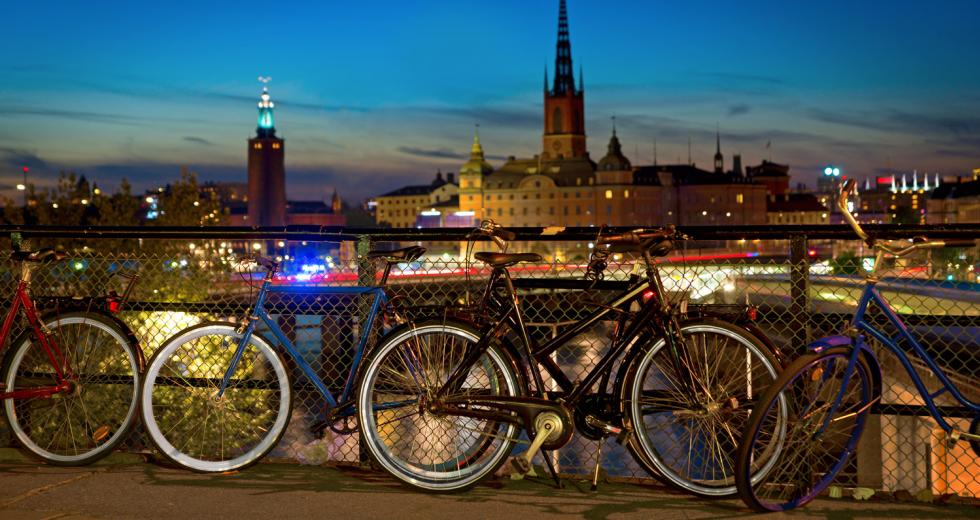Sacramento to Stockholm: It takes about a day to travel between these two capital cities. But they have more similarities than you might think, considering they are half a world apart. They also have lessons to teach each other. I’ve gained some insight into these lessons as both a native of Sacramento and now as a resident of Stockholm for the past six years.
Expanding Bike Infrastructure
Cycling in a city can be scary, no matter what city you are cycling in. In Stockholm, the local government is slowly developing the cycling infrastructure: adding more parking racks for bikes, expanding bicycle lanes and even building physical barriers between car and bike lanes on one main road. The city already has streets designated as bike routes, with signs noting distances to places of interest, from universities to downtown.
Related: Spinning Wheels
Bicycle lanes already connect the outer suburbs to the main inner core of Stockholm, making commuting feasible — at least for part of the year (it can get awfully cold here, and some diehard cyclists get tires with spikes for ice and snow). And the public-private city-wide bicycle program, City Bikes, has 140 stations across town at which people can rent bikes at one location and then deposit them at another, and an app to tell you where bikes (or parking places) are available. It’s no surprise to see people commuting on the shared bikes, from April to October, and they’re a favorite of tourists too.
Stockholm Mayor Daniel Helldén is committed to expanding the infrastructure to get more people on their bikes — the current political coalition that makes up the city council has pledged to spend a billion Swedish kronor (the equivalent of about $116 million USD) to pay for bicycle bridges, more parking for bicycles in public sheds or street racks and other amenities.
Meanwhile, Sacramento has long been a cyclist’s city, but that’s mostly because of the American River Parkway. Lycra-clad speedsters and weekend joy riders are out year-round on those dedicated bike paths. Some hardy cyclists commute from as far out as Folsom into the capital city, but the total number of cyclists within Sacramento has remained about the same over the past few years, according to Sacramento Area Bicycle Advocates. This is disappointing because in many other cities, such as Minneapolis, Pittsburgh and Seattle, rates of urban cycling are on the rise.
The City of Sacramento updated its Bicycle Master Plan in August 2016, which outlines the development of bikeways, educational programs to encourage people to hop on their bikes and facilities such as bike parking. And while there are plenty of promising elements to the plan, implementation will take 20 years and there’s no money attached to it.
When it comes to biking, Stockholm can reinforce the lesson to Sacramento that residents and tourists alike appreciate and benefit from a robust infrastructure for cyclists — the things that make getting on a bike easier to do than getting in a car. Plus bicycling cuts down on car emissions while getting people active, which are two direct ways to improve health and quality of life.
Appreciating Waterways
Stockholm is Sweden’s Venice — its city on the water, and the city of 14 islands. In the warmer seasons, Stockholmers can take boats for their commute from the outer boroughs. Kayakers, canoers, even cruise ships ply the inner harbor of the city and freshwater Lake Malaren, where houseboats and boat hostels dock on the city quays.
But Sacramento has Stockholm beat when it comes to river rafting on the Sacramento and American Rivers, and canoeing on Lake Natoma. Both cities know how to enjoy their waterways. While Sacramento must protect itself from flooding, Stockholm is slowly rising out of the water: When the ice sheets that once covered the area receded, the land started to bounce back after all that weight was removed. The islands that make up the city rise about a fifth of an inch a year.
Also unlike California, Sweden doesn’t worry about water shortages. Both Sacramento and Stockholm get about 2 feet of precipitation a year, but Stockholm gets its rain and snowfall year round, plus the snow runoff from farther inland feeds rivers and lakes. As a result, native Stockholmers tend to let their taps run.
But the city’s water company encourages protecting the region’s water resources in other ways: Back in the 1970s, the waters around the city were too polluted with nutrients from agricultural runoff and other sources to swim in or fish. Today, after civic and government partnerships brought farmers and fishermen and everyday people together to protect the Baltic, the water is almost clean enough to drink (though you wouldn’t want to — the Baltic is brackish, and there’s still some stuff in there that probably would be detrimental to one’s health). Their efforts included: regulations and cooperative learning programs for farmers and rural communities; cutting back on polluting fertilizers to installing better septic tanks for rural homes; and even separating urine from solid waste, for reuse in irrigation. Controlling dumping and surface runoff in urban areas also helps.
Several thousand gallons of water a second travel through Henriksdal, one of the main water treatment plants in the city. Here, microbes, filters and sand traps remove pollutants such as nutrients — phosphorus and nitrogen, most likely as runoff from farm animals and croplands that run off into Stockholm’s Lake Malaren, for example — to get the water clean enough to release it to the Baltic. Human waste is separated out and turned into biogas to run the city’s buses, and the water treatment plant also ends up plucking out other kinds of human waste: smashed cell phones, plastic dolls, metal bottle caps and more. The city runs regular campaigns to remind people not to flush trash down the toilet.
Related: Bridge Over Troubled Waters
It takes cooperation to protect a resource like water, from farms to toilets. Saving a flush in times of drought in Sacramento has become normal, as has not washing your car or watering your lawn. But other ingenious solutions to protect a valuable resource include encouraging xeriscaping with rebates through the city’s river-friendly landscaping program, and non-potable water reuse to irrigate highway median plants and more.
Doing Adaptive Reuse
Reduce, reuse, recycle … your buildings.
One of the best views of Stockholm can be had from the top-floor café at Fotografiska, a privately-owned photography museum opened in 2010. Its gigantic plate glass windows frame the old city on Gamla Stan, the former royal ship-building island of Skeppsholmen, and the Gronalund amusement park and Djurgården National Park across the open water.
Those windows were once the portals to the city’s customs house, built in 1906, which the museum now inhabits. The large spaces easily converted to excellent exhibit rooms. This kind of adaptive reuse of the grand old buildings with good bones can be seen across the city of Stockholm: The old military college now houses private companies and a gym, and apartment buildings have sprung up on the old parade grounds. The Asian Art Museum uses old military barracks and the underground bomb shelters as exhibition spaces. Even old ships have been turned into hotels, like one youth hostel anchored permanently across from the royal palace.
Sacramento, despite its relative youth (Stockholm was established in 1250, while Sacramento’s history dates back to 1850), has its own tradition of recycling old infrastructure. Of course, there’s Old Sacramento — but recent projects such as the M.A.Y. Building, Ice Blocks retail and housing development and the Railyards urban infill undertaking, which will incorporate a soccer stadium for the Republic FC among other elements, show that the city has embraced adaptive reuse and recycling of its old structures. The value of adaptive reuse has not been a hard lesson to learn in the relatively New World of the Wild West.




